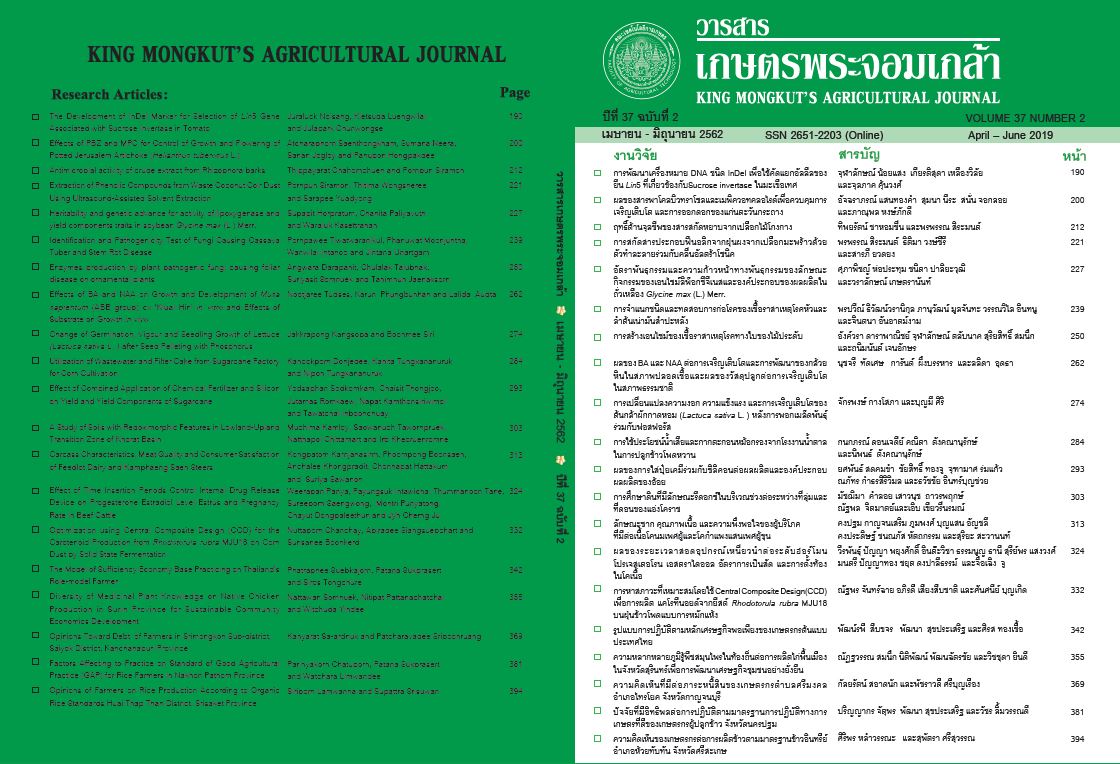ฤทธิ์ต้านจุลชีพของสารสกัดหยาบจากเปลือกไม้โกงกาง
Main Article Content
บทคัดย่อ
ฤทธิ์ต้านเชื้อจุลชีพของสารสกัดหยาบที่สกัดได้จากเปลือกไม้โกงกาง ทดสอบประสิทธิภาพในการยับยั้ง
การเจริญของเชื้อราในกลุ่มเดอร์มาโตไฟท์ 5 ชนิดคือ Epidermophyton floccuosum, Microsporum canis,
Microsporum gypseum, Trichophyton ruburm และ Trichophyton mentagrophyte และเชื้อแบคทีเรีย 4 สาย
พันธุ์ คือ Escherichia coli, Micrococcus spp., Staphylococcus aureus และ Streptococcus pneumonia ผล
การทดสอบฤทธิ์ต้านเชื้อราพบว่า ที่ระดับความเข้มข้น 10.0 มก./มล. สารสกัดหยาบสามารถยับยั้งการเจริญของเชื้อ
ราได้ในระดับ 50-80 % และสามารถยับยั้งการเจริญของเชื้อ M.gypseum ได้สุงสุด รองลงมาคือ M.canis,
T. mentagrophyte, E. floccuosum และ T. rubrum ตามลำดับ ผลการทดสอบฤทธิ์ในการยับยั้งการเจริญของเชื้อ
แบคทีเรียด้วยวิธี Broth dilution method พบว่าสารสกัดหยาบมีประสิทธิภาพในการยับยั้งการเจริญของเชื้อแบคทีเรีย
แกรมบวกได้ดี มีค่า MIC อยู่ในช่วงระหว่าง 5.0 ถึง 10.0 มก./มล. แต่ไม่สามารถยับยั้งการเจริญของเชื้อแบคทีเรีย
E. coli ได้ที่ระดับความเข้มข้นที่ทดสอบ ผลการศึกษานี้มีศกั ยภาพในการนำ ไปพัฒนาผลิตภัณฑ์เพื่อควบคุมหรือยับยั้ง
การเจริญของเชื้อราก่อโรคกลากและแบคทีเรียก่อโรคได้
Article Details
วารสารเกษตรพระจอมเกล้า
เอกสารอ้างอิง
พีบีเอส. กรุงเทพฯ. ออกอากาศ 4 ก.ย. 2559. แหล่งที่มา: https://www.youtube.com/watch?v=K7rADz4YPnE
พรพรรณ สิระมนต์ และทิพยรัตน์ ชาหอมชื่น. 2558. ฤทธิ์ต้านเชื้อราของสารประกอบฟีนอลิคจากเปลือกผลสบู่ดำ. วารสาร มทร. อีสาน.
ฉบับพิเศษ: 76-82.
Adnan, S.N.A., N. Ibrahim, and W.A. Yaacob. 2017. Disruption of methicillin-resistant Staphylococcus aureus protein
synthesis by tannins. GERMS 7(4): 186-192.
Basri, D.F., R. Sharif, P. Morat, and J. Latip. 2005. Evaluation of antimicrobial activitys of the crude extracts from Garcinia
atroviridis and Solanum torvum. Malaysian Journal of Science 24: 233-238.
Buma, R., T. Maeda, M. Kamei, and H. Kourai. 2006. Pathogenic bacteria carried by companion animals and their
susceptibility to antibacterial agents. Biocontrol Science 11(1): 1-9.
Castillo, F., D. Hernandez, G. Gallegos, M. Mendez, R. Rodriguez, A. Reyes, and C.N. Aguilar. 2010. In vitro antifungal
activity of plant extracts obtained with alternative organic solvents against Rhizoctonia solani Kuhn. Industrial Crops
and Products 32(3): 324-328.
Chuku, A. and O.O. Nwankiti, 2013. Association of bacteria with fungal infection of skin and soft tissue lesions in plateau
state, Nigeria. British Microbiology Research Journal 3(4)L 470-477.
Croxen, M.A., R.J. Law, R. Scholz, K.M. Keeney, M. Wlodarska, and B.B. Finlay. 2013. Recent advances in understanding
enteric pathogenic Escherichia coli. Clinical Microbiology Reviews 26(4): 822-880.
Giovana, M.L., L.F. Ana, S.C. Valeria, W.B. Bianca, G. Silvana, F.A. Saulo, C.F. Suzelei, and M.S. Ana, 2013. Antimicrobial
activity and rates of Tannins in Stryphnodendron adstringens Mart. Accessions collected in the Brazilian Cerrado.
American Journal of Plant Sciences 4: 2193-2198.
Havlickova, B., V.A. Czaika, and M. Friedrich. 2008. Epidemiological trends in skin mycoses worldwide. Mycoses
51 Suppl 4, 2-15.
Hoong, Y.B., M.T. Paridah, C.A. Luqman, M.P. Koh, and Y.F. Loh, 2009. Fortification of sulfited tannin from the bark of
Acacia mangium with phenol–formaldehyde for use as plywood adhesive. Industrial Crops and Products 30(3): 416-421.
Hussey, S.J.K., J. Purves, N. Allcock, V.E. Fernandes, P.S. Monks, J.M. Ketley, P.W. Andrew, and J.A. Morrissey, 2017. Air
pollution alters Staphylococcus aureus and Streptococcus pneumonia biofilms, antibiotic tolerance and colonization.
Environmental microbiology 19(5): 1868-1880.
Ismael, H.M. and N.A. Ramadan. 2013. The anti-dermatophyte activities of some plant extracts against Trichophyton
mentagrophytes and Microsporum canis. Journal of University of Zakho 1(2): 463-468.
Kandeel, A., K. Abu-Elmagd, M. Spinner, A. Khanna, K. Hashimoto, M. Fujiki, and A. Abd-Elaal. 2015. A typical Clinical
Presentation of a Newer Generation Anti-Fungal Drug-Resistant Fusarium Infection After a Modified Multi-Visceral
Transplant. Annals of Transplantation 20: 512-518.
Kim, S.H., S.H. Cho, S.K. Youn, J.S. Park, J.T. Choi, Y.S. Bak, Y.B Yu, and Y.K. Kim, 2015. Epidemiological Characterization
of skin fungal infections between the years 2006 and 2010 in Korea. Osong Public Health Perspect 6(6): 341-345.
Lim, S.H., I. Darah, and K. Jain. 2006. Antimicrobial Activities of Tannins Extracted from Rhizophora Apiculatus Barks.
Journal of Tropical Forest Science 18: 59-65.
Marino, M., C. Bersani, and G. Comi. 2001.Impedance measurements to study the antimicrobial activity of essential oils
from Lamiaceae and Compositae. Int J Food Microbiol 67: 187-195.
Min, B.R., W.E. Pinchak, R. Merkel, S. Walker, G. Tomita, and R.C. Anderson. 2008. Comparative antimicrobial activity
of tannin extracts from perennial plants on mastitis pathogens. Scientific Research and Essay 3(2): 066-073.
Muangkaew, W., T. Wongsuk, and N. Luplertlop. 2017. Common dermtophytes and in vitro anti-fungal susceptibility
testing in patients attending the Dermatological Clinic at the Hospital fro Tropical Medicine, Bangkok.
New Microbiologica 40(3): 175-179.
Neimsuwan, T., P. Siramon, P. Hengniran, and V. Punsuvon, 2017. Tannin Extraction of Rhizophora Bark from Residual
Charcoal Production. Journal of Tropical Forest Research 1(1): 36-50.
O’Neill, J. 2016. Tackling drug-resistant infections globally: The review on antimicrobial resistance. Final report and
recommendations. London: HM Government and the Welcome Trust 84 p.
Panizzi, L., C. Caponi, S. Catalano, P.L. Cioni, and I. Morelli. 2002. In vitro antimicrobial activity of extracts and isolated
constituents of Rubus ulmifolius. Journal of Ethnopharmacology 79(2): 165-168.
Rajendra, S., P. Karthick, M.K. Narayana, C. Ramesh, R. Mohanraju, and A. Vijayakumar, 2016. Evaluation of antimicrobial
properties from the mangrove Rhizophora apiculata and Bruguiera gymnorrhiza of Burmanallah coast, South Andaman,
India. Journal of Coastal Live Medicine 4(6): 475-478.
Redondo, L.M., P.A. Chacana, J.E. Dominguez, and M.E.F. Miyakawa, 2014. Perspectives in the use of tannins as alternative
to antimicrobial growth promoter factors in poultry. Frontiers in Microbiology 5: 1-7.
Salih, E.Y.A., M. Kanninen, M. Sipi, O. Luukkanen, R. Hiltunen, H. Vuorela, R. Julkunen-Tiitto, and P. Fyhrquist, 2017. Tannins,
flavonoids and stilbenes in extracts of African savanna woodland trees Terminalia brownie, Terminalia laxiflora and
Anogeissus leiocarpus showing promising antibacterial potential. South African Journal of Botany 108: 370-386.
Seyedmousavi, S., J. Guillot, A. Tolooe, P.E. Verweij and G.S. Hoog. 2015. Neglected fungal zoonoses: hidden threats to
man and animals. Clinical Microbiology and Infection 21(5): 416-425.
Sung, S.H, K.H. Kim, B.T. Jeon, S.H. Cheong, J.H. Park, D.H. Kim, H.J. Kweon and S.H. Moon. 2012. Antibacterial and
antioxidant activities of tannins extracted from agricultural by-products. Journal of Medicinal Plants Research 6(15):
3072-3079.
Suraya, S., I. Darah, K. Jain, and S.H. Lim. 2011. Antimicrobial and antioxidant activities of condensed tannin from
Rhizophora apiculata barks. Journal of Chemical and Pharmaceutical Research 3: 436-444.
Tomiyama, K., Y. Mukai, M. Saito, K. Watanabe, H. Kumada, T. Nihei, N. Hamada and Teranaka, T. 2016. Antibacterial
Action of a Condensed Tannin Extracted from Astringent Persimmon as a Component of Food Addictive Pancil PS-M
on Oral Polymicrobial Biofilms. Biomed Research International 2016: 1-7.
Ungpakorn, R. 2005. Mycoses in Thailand: Current Concerns. Japanese Journal of Medical Mycology 46: 81-86.
Woodford, N. and D. Livermore. 2009. Infections caused by Gram-positive bacteria: a review of the global challenge.
Journal of Infection 59(S1): S4-S16.


